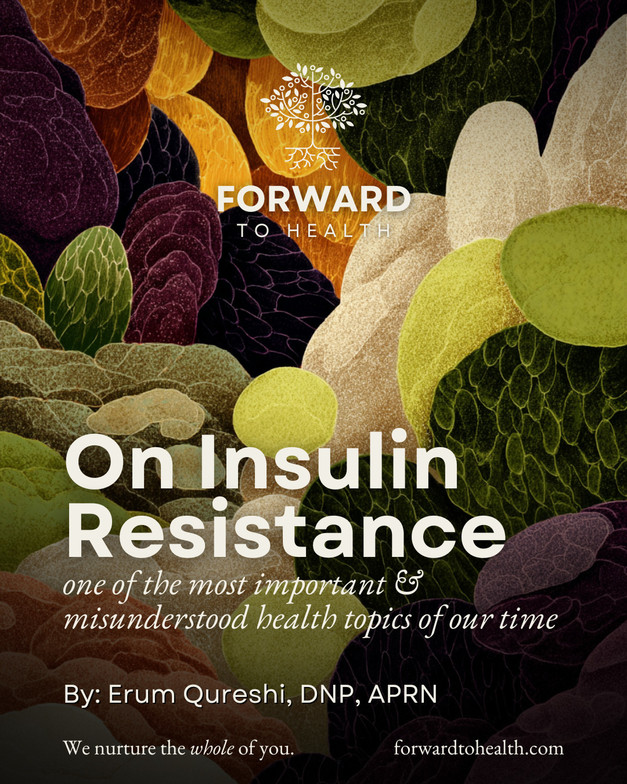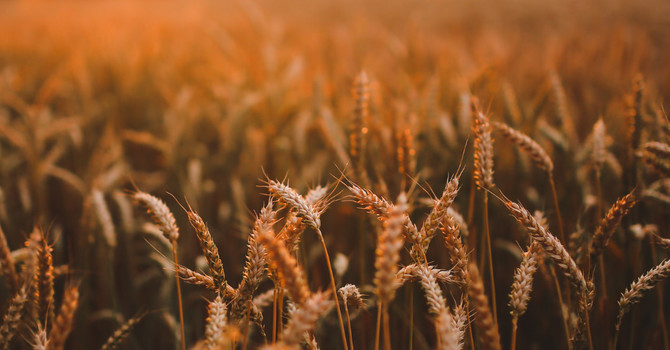
On Insulin Resistance
Insulin resistance might not sound exciting, but trust me - it’s one of the most important and misunderstood health topics of our time. This sneaky condition is behind a whole bunch of modern health issues, especially Type 2 Diabetes.
What’s even worst is the number of medications flooding the market to “manage” this issue. With the Ozempic craze taking over social media, it feels like we’ve hit peak confusion about what insulin resistance really is - and how we should be addressing it.
So, here... let’s just dive into this:
Insulin resistance isn’t just a random diagnosis. It’s deeply connected to how we eat, move, sleep, and live in this fast-paced modern world. So, before we reach for another miracle fix, let’s take a step back and actually understand what’s going on in our bodies.
What is Insulin Resistance?
Insulin resistance is a metabolic condition in which the body’s cells - especially those in muscle, fat, and liver tissues - become less responsive to insulin, a hormone essential for regulating blood sugar, which serves as a key source of energy, nourishment, and growth. This reduced sensitivity causes blood glucose levels to rise, prompting the pancreas to produce more insulin to compensate. Over time, this compensation weakens, leading to persistently elevated blood sugar and further impairment of insulin receptor function on the cells.
It's also important to keep in mind that insulin receptors are found throughout the body - on the cells surrounding our ovaries, in the brain, stomach, and muscles, because after all it will be a source of energy to the organs. So, when there is diminished responsiveness to insulin, it affects the entire body.
- In the brain, it alters cognitive and metabolic regulation, and has been linked to Alzheimer’s disease, often referred to as “Type 3 diabetes.”
- In the ovaries, it disrupts hormone synthesis, contributing to conditions like PCOS and other hormonal imbalances.
- In the stomach and digestive tract, it interferes with metabolic signaling, affecting how nutrients are processed and delivered to the rest of the body.
- And in the muscles, it impairs glucose uptake and energy utilization, leading to fatigue, reduced strength, and overall decreased physical performance, to say the least.
We know the modern approach to treating this condition, typically involves measuring your Hemoglobin A1C and setting a target goal. Practitioners then create a diet and exercise plan, maybe they address stress and sleep, and usually prescribe multiple medications. I’m not trying to dismiss this approach - there is definitely a place for it. But is it truly healing?
Exploring Unani Tibb’s Understanding of Insulin Resistance and Diabetes
In the science of Unani Medicine (Tibb), insulin resistance and diabetes are recognized as modern manifestations of deeper imbalances in the body’s natural temperament and lifestyle. These conditions are often linked to a disturbance in the Six Essential Lifestyle Factors, which include:
- Air,
- Food & Drink,
- Movement & Rest,
- Sleep & Wakefulness,
- Retention & Elimination,
- and Emotional Health.
When these factors fall out of harmony, the body’s natural temperament shifts - in the case of diabetes and insulin resistance, this usually persents as an excess of coldness and dryness. This imbalance particularly affects the liver, stomach, and kidneys, organs that play essential roles in digestion, metabolism, and hormonal regulation.
In Unani understanding, diabetes is primarily considered a disorder of Phlegm (Balgham) and Black Bile (Sauda).
In Unani medicine, health is maintained through the balance of four fundamental humors: Blood humour (Dam), Phlegm (Balgham), Yellow bile (Safra) Black bile (Sauda).
These humors are formed through the process of digestion and metabolism. Food is first transformed into a substance called Chyle in the stomach and intestines, which then passes to the liver where it is refined into these four humors.
- Dam (Blood): hot and moist - provides vitality and nourishment.
- Balgham (Phlegm): cold and moist - provides lubrication, nourishment, and cooling.
- Safra (Yellow bile): hot and dry - supports metabolism and energy.
- Sauda (Black bile): cold and dry - stabilizes mood and structure.
The quality and balance of the humors are shaped by the Six Lifestyle Factors, especially nutrition.
The Role of Balgham (Phlegm Humor)
Primary functions of Balgham:
- Provides lubrication and moisture to the joints and tissues.
- Offers nourishment and acts as a reserve source of energy.
- Maintains softness, flexibility, and smooth physiological processes.
- Supports cooling and the balance of internal temperature.
When Balgham becomes excessive or stagnant, it slows the body’s metabolic processes, leading to multiple disorders - including insulin resistance and diabetes.
Since humors are formed directly from what we eat, nutrition is the primary means of restoring balance. The modern diets often contain excessive cold and moist foods such as bread, refined sugar, dairy, and processed foods. These aggravate phlegm and suppress metabolism.
How Phlegmatic Imbalance Leads to Insulin Resistance and Hormonal Dysregulation
An excess of cold and moist phlegmatic humor weakens digestive fire, leading to sluggish metabolism and poor transformation of nutrients into usable energy. This results in:
- Accumulation of undigested matter in the bloodstream, causing inflammation and metabolic blockages.
- Reduced insulin sensitivity, as the cells become less responsive due to the cold and damp internal environment.
- Hormonal imbalance, since the endocrine system depends on the balance of heat, moisture, and circulation.
- Fatigue, weight gain, and sugar cravings, which further perpetuate phlegmatic excess.
Over time, this imbalance disrupts the liver’s ability to process glucose properly and the kidneys’ role in filtering waste - both of which are key organs in Unani understanding of diabetes.
Ways to Help Balance Diet and Lifestyle
For Chronic Health Issues such as Diabetes, Insulin Resistance, and PCOS
-
First Things First - Shifa (Healing) Comes from Allah.
True healing comes only from Allah. Medicine, food, or any other means have effect only through His permission. Make du‘a, ask for Shifa, and recite Surah Al-Fatiha regularly. Have full trust and certainty that your prayer is accepted and that healing will come, Insha’Allah.
2. Be Present in Your Breath.
Breath is life - it was the first thing breathed into us and will be the last thing taken away. Start your mornings with a few deep, mindful breaths add dhikr as you do some deep breathing. This will center your mind in gratitude for what is, rather than what is not. This helps regulate cortisol levels and reduces stress. Most of us live in a constant “fight or flight” mode, which raises stress hormones like cortisol, leading to hormonal imbalance and nutrient misdistribution. Mindful breathing brings calm to the nervous system and restores balance to the body and mind.
3. Move Daily - Regulate the Body’s Natural Flow.
Even in a busy lifestyle, intentional movement is essential. Walk daily, stretch, or engage in gentle exercise to help the body regulate internal functions and clear the channels for the proper flow of humors. Regular movement supports detoxification, improves digestion, and uplifts mood.
4. Include Bitters in Your Diet.
Bitters help cleanse the liver, improve digestion, and balance blood sugar. Incorporate foods such as: Arugula, Bitter gourd/melon, Endive, Chicory, Green tea, Fenugreek, Turmeric, Citrus peel, Grapefruit, and Olives.
5. Supportive Herbs and Seeds for Hormonal Balance.
These natural foods and herbs help regulate hormones and support detoxification: Black seed (Nigella sativa), Cinnamon, Jaggery (as a natural sweetener), Fenugreek seeds, and Moringa.
6. Practice Proper Nutrition and Mindful Eating
- Focus on whole, natural foods.
- Avoid excessive dairy, sugar, processed carbohydrates, and processed foods.
- Include Prophetic foods such as Talbina (barley porridge) regularly in your diet.
- Choose light, easy-to-digest meals for lunch such as khichdi/khichri (mung dal and rice).
- Limit red meat, as it often contains added hormones and antibiotics; choose organic or grass-fed sources when possible.
- Eat as organic and natural as your means allow.
- Spend time cooking at home - it nurtures your connection with food and health.
- Engage in Dhikr (remembrance of Allah) while cooking. Prepare food in a happy, peaceful state, as your energy and mood transfer into the food you make and, in turn, affect your health.
7. Align Routine, Fasting, and Meals with Natural Rhythms
- Make it a habit to fast at least once a week (preferably twice), or begin with intermittent fasting if that’s more manageable.
- Plan your meals and activities around the times of Salah to stay spiritually and physically aligned.
- After Fajr, drink warm water with lemon or black seed tea to awaken digestion.
- Breakfast: Start with low-sugar fruits such as pomegranate, apples (organic), berries, or oranges. Follow with oats, eggs with vegetables, or talbina.
- Lunch (after Dhuhr): Enjoy salads with ginger, nuts, and black pepper dressing, or light meals like khichri or soups.
- Dinner (after Maghrib): Eat with family, followed by a gentle post-dinner walk and quality family time.
- After Isha: Unplug from electronics, spend time in Qur’an recitation and Dhikr before sleep to calm the heart and prepare for rest.
Healing is not found in quick fixes or prescriptions alone - it is found in restoring harmony between the body, mind, and soul. Insulin resistance is not just a disease of sugar, but a reflection of imbalance in our lifestyles, our emotions, and even our spiritual health.
When we return to the wisdom of balance - through Dhikr (remembrance of God), mindful eating, movement, and gratitude - the body begins to heal naturally. May Allah grant all of us shifa, balance, and the strength to care for the trust He has placed within us - our body.
Erum Qureshi
Doctor of Nursing Practice with supplemental training in Unani Tibb & Holistic Nutrition
Contact Me


